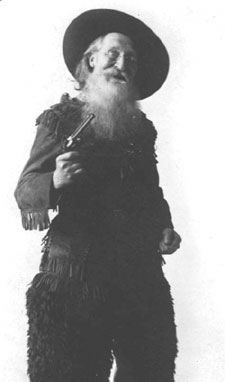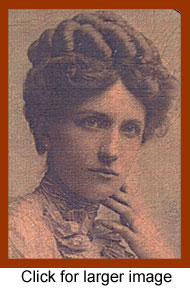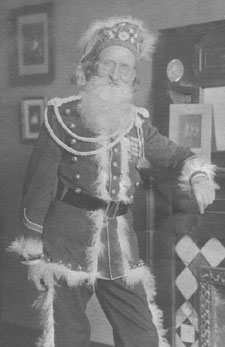|
John Harwood Pierce
Biography: Part 6 1908 to 1925
 Jack of All Trades.
In the early twentieth century, it wasn't easy making a good living as an orator; people
were into other forms of entertainment. Orators did not draw large audiences, and the
days of the Wild West shows were long gone. In addition, John was too old to travel. As a
public speaker, he did small engagements in churches, and at other events held in
local halls in the San Francisco Bay area. Being a public speaker didn't bring in enough
money, but it did feed his large ego and got him press coverage from time to time.
John supplemented his speaker's income by becoming a jack of all trades.
Jack of All Trades.
In the early twentieth century, it wasn't easy making a good living as an orator; people
were into other forms of entertainment. Orators did not draw large audiences, and the
days of the Wild West shows were long gone. In addition, John was too old to travel. As a
public speaker, he did small engagements in churches, and at other events held in
local halls in the San Francisco Bay area. Being a public speaker didn't bring in enough
money, but it did feed his large ego and got him press coverage from time to time.
John supplemented his speaker's income by becoming a jack of all trades.
- Hired Himself Out as an Entertainer. John continued to sell his
skills as an entertainer and orator. He advertised that he could: deliver monologues;
recite his own or other poet's poems; give lectures on topics of current interest;
tell fantastic, true stories about his experiences in the Civil War;
deliver patriotic speeches; tell amazing stories about his
Wild West days, and the Indian Wars of the Black Hills;
and finally, he could entertain audiences by doing full military Zouave drills.
- Writer of Legal Papers. John wrote and sold common legal documents such as
wills.
- Writer of Advertisements. John used his creative and marketing skills to write,
illustrate, and typeset advertising copy for small businesses. He specialized in
writing advertiscements that used catchy rhymes.
- Notary Public. John was officially licensed as a notary.
His offices were immediately across from Oakland City Hall, so he did
considerable business in this capacity.
- Served as a Marrying Minister. John was extraordinarily successful as a
marrying minister. Because his offices were across the street from the City Hall, he
easily caught the attention of almost everyone going there to obtain a marriage license.
Furthermore, he solicited their business by watching for likely couples from his
second floor offices, and once spotted, he would use a megaphone to try to convince them
to come to his offices to solemnize their marriage immediately after getting their license.
He also advertised that he could expedite confidential marriages under Section 79 of
the California Civil Code. He could do this because he was both a notary and a minister. He
became so successful and well known as a marrying minister that in the press and
on the street he was referred to as The Famous Oakland Marrying Minister.
- Sold Real Estate and Insurance, Loans. John sold real estate and insurance. In
addition, he used his own capital to make loans.
 Inventor. John invented, manufactured and sold, at a small steady profit, a
type of wall bed; drawing for this bed look much like today's Murphy Bed. In addition,
he continued to try to promote his pneumatic passenger tube idea; this time the device
was to run under the San Francisco Bay between Oakland and San Francisco. He received
considerable attention in the San Francisco and Oakland papers for this idea, but the
newspaper articles were sensational journalism rather than scientific. Lastly, he had
another grand idea that he tried to get investors interested in; this one was for a
a hydroplane.
Inventor. John invented, manufactured and sold, at a small steady profit, a
type of wall bed; drawing for this bed look much like today's Murphy Bed. In addition,
he continued to try to promote his pneumatic passenger tube idea; this time the device
was to run under the San Francisco Bay between Oakland and San Francisco. He received
considerable attention in the San Francisco and Oakland papers for this idea, but the
newspaper articles were sensational journalism rather than scientific. Lastly, he had
another grand idea that he tried to get investors interested in; this one was for a
a hydroplane.
In short, John became famous throughout Oakland and much of the Bay Area
as a beloved, colorful, energetic, and magnificent eccentric!
Oakland Marrying Minister. The following newspaper clippings among John's
personal papers gives a vivid desciption of John at this time in his life. In
addition, the article gives significant details about how John earned his reputation
as The Famous Oakland Marrying Minister. The article is the same
Oakland Tribune article referred to a number of times earlier in this
biography. The part about his serving as a marrying minister reads, in part:
"I am the product of the wilds," declared the
marrying parson gravely shaping his white beard.
At that instant, he was permitting the graphaphone to rest from its
arduous labors of the forenoon and the early afternoon. Its formidable
mahogany box concealing its strange organs, stood unshaken by canned
melody; the big horn above--thrust through the window into the
street--had the air of a person who had turned his back on the room.
Usually the Reverend Mr. Pierce has it going--serenading the passers-by
on the pavement below until they inevitably glance up at the sign below
his little bay window screened with yellow curtains. This sign, of deep
blue, announces in startling silvery letters of impressive size,
Weddings.
Impossible--once having looked up, for them not to read the words and
the rate quoted below in figures of a height legible even to weak eyes.
Two people of any age, issuing from the county clerk's office in the
Hall of Records across the street, all armed with a license, could
scarcely fail to see it. Many a person strolling unsuspectingly along
Broadway has had his thoughts diverted into matrimonial channels by that
announcement.
It is estimated that he married over 1,000 couples a year.
 John "Married" Jennie Schoofs. John was a colorful, energetic,
charismatic, and bigger-than-life eccentric, and for an old man, he was still
good looking. Also, he knew exactly how to charm the ladies. In 1910, when John
was 62 years old, he met Johanna (Jennie) Dorathea Schoofs, a 27-years-old
devout Catholic who had once studied to be a nun. At the time, Jennie
had traveled to Oakland, from her home in Wisconsin, to visit her
married sister, Margaret. She was naive, and easily charmed by John's
engaging personality and stories of famous exploits. On September 2,
1910, John "married" Jennie, but he did not tell her that
he was still legally married to Clara. In fact, John only informed Jennie
about his first marriage to Marie. She knew nothing about his second,
third and fourth wives! Jennie was Catholic, so of course, he could not tell her
about his two divorces. As a devote Catholic, Jennie would not have married
any man who was divorced.
John "Married" Jennie Schoofs. John was a colorful, energetic,
charismatic, and bigger-than-life eccentric, and for an old man, he was still
good looking. Also, he knew exactly how to charm the ladies. In 1910, when John
was 62 years old, he met Johanna (Jennie) Dorathea Schoofs, a 27-years-old
devout Catholic who had once studied to be a nun. At the time, Jennie
had traveled to Oakland, from her home in Wisconsin, to visit her
married sister, Margaret. She was naive, and easily charmed by John's
engaging personality and stories of famous exploits. On September 2,
1910, John "married" Jennie, but he did not tell her that
he was still legally married to Clara. In fact, John only informed Jennie
about his first marriage to Marie. She knew nothing about his second,
third and fourth wives! Jennie was Catholic, so of course, he could not tell her
about his two divorces. As a devote Catholic, Jennie would not have married
any man who was divorced.
Clara and Council Lived Nearby; They Did Not Reveal Themselves to Jennie.
Clara, John's legal wife, lived only a few short blocks away from where
Jennie and John made their home in Oakland. Apparently, she knew about John's
"marriage" to Jennie, but tolerated it in silence. One has to assume that
Clara continued to get financial support from John. There was obviously no
longer any loving feelings between the two. As a devote Catholic, John
knew that Jennie would not marry him if he was a divorced man. So, he
had to hide the fact that he was married. As long as he continued to
support her, Clara was prepared to help him with this deception.
Birth of Melvin.
On July 17, 1911, a year after they were married,
John and Jennie had a son. They named him Melvin John Pierce. Among John's
archives is Melvin's baby book. It records in detail all the important
episodes in Melvins life up until he was about 7 years old. The book was
kept methodically by both parents and shows that both parents doted on every
detail of their child's maturation process. The book also gives a wonderful
glimps into the daily life of John, Jennie and Melvin. It reveals
a perfectly normal family life. Melvin was a treasured son. He was showered
with presents on his birthday and at Christmas. He was taken to baby shows and
won first prize for his handsome looks. He was taken ever sunday to church.
Eventually, he became part of the children's chorus. Once he sang solo for
the entire congregation. The book records many of the memorable cute
things that Melvin would say as he lerned to talk and grew through childhood.
Reading the words of the small child, it is obvious that he loved
his mother and father and had a perfectly normal, happy young childhood.
 King of Fairies and All Year Santa Claus.
In October of 1915, San Francisco was the location of an very important and large
exposition called the Panama Pacific Exposition. In conjunction with this
exposition was a gala costume party. John spent a great deal of time and effort
making a unique costume. It was a military uniform trimmed in white fur with a
special hat covered with huge, fake jewels. He called himself the King of Fairies,
but others called him Santa Claus. Among the 18,000 contestants, his costume won
first prize. The following is a quote from the San Francisco Examiner,
concerning this event.
King of Fairies and All Year Santa Claus.
In October of 1915, San Francisco was the location of an very important and large
exposition called the Panama Pacific Exposition. In conjunction with this
exposition was a gala costume party. John spent a great deal of time and effort
making a unique costume. It was a military uniform trimmed in white fur with a
special hat covered with huge, fake jewels. He called himself the King of Fairies,
but others called him Santa Claus. Among the 18,000 contestants, his costume won
first prize. The following is a quote from the San Francisco Examiner,
concerning this event.
"Who would have guessed that the Rev. J. H. Pierce, late President of this, and
Colonel of that, an Honorable too--only a few votes shy--would grow long hair
and let his vandyke wave unmowed until the wind blew through his whiskers.?
Ah well, it is all to please the kiddies. It has long been an open secret that
the Bay Cities had the World's Champion Entertainer of children, and when the
Colonel won that prize, as Santa Claus, at the Ball of All Nations, we knew
that his gems would bankrupt rockefeller if they were from Africa and India,
and the tailor--well his bill was--really now, no one is telling. It was THE
costume all right."
Once again John was
interviewed by the press and enjoyed a fair amount of publicity. Soon afterwards,
John started selling himself as an entertainer for children, specifically as a
year-round Santa Claus. He made a great deal of money at this.
Birth of Stella.
Seven years after Melvin was born, John and Jennie had another baby, a girl.
They named her Stella May in honor of one of John's neices, Stella May Smith
(Clarissa's daughter), who was at that time a married woman of 45.
As is often typical for the second child, John and Jennie kept no baby book for
Stella. Nevertheless, one can assume that both parents doted on their baby girl
in much the same fashion as the did with Melvin.
Council Brought Trouble to Jennie and John. Sometime around late 1919, or
early 1920, something terrible appears to have happened in the Pierce household.
Piecing together recollections of family conversations between Jennie and Stella as adults, it
appears that at this time Jennie first learned about John's marriage to Clara
and about the existence of their son Council. As an old woman, long after John's
death, Jennie could never talk about Council. If his name were ever mentioned
in her presence, Jennie would throw her hands to her head and moan loudly
over and over again in obvious great psychological pain, "Council!
Council!" At the same time she would walk or turn away in silence
from whomever had brought up the subject of Council's name. Jennie never
talked about her past; it caused her too much pain to think about it. One can
only assume that it was Council who, for whatever reason, broke the news to Jennie that
John was still legally married to his mother. Perhaps he also called her unspeakable
names--names that were forever branded on her delicate soul.
What might have caused Council to do such a thing? Looking through John's
archives, one finds a newspaper clipping that appeared in the
Oakland Daily Post in November of 1919. The article was headed Vets Meet After
55 Years, and the
full text of that
article is appended to this biography. In brief, the article tells about
a chance meeting in the offices of the Oakland Daily Post between John Harwood Pierce
and a former Civil War friend. More than half a century earlier, the two men had known each
other in a Civil War prison at Camp Douglas, Illinois. One was a captive drummer boy of a
Virginia regiment, Charles Morey, and the other was a Yankee corporal, John H. Pierce, acting
as prison gruard while convalescing from a shell wound. Charles H. Morey was now the
dashing 70-years-young movie actor from Los Angeles, and familiar to millions of movie
fans the world over as the man who played the part of Robert E. Lee in the
Birth of a Nation. The article has this entertaining and amusing clincher at
its end:
And such an inexhaustible fund of yarns they had to tell. Neither could out do
the other. So, at last Morey told the colonel of his charming young bride of
thirty-five; it was the last and biggest shot in his locker, and he watched with
boyish eagerness for its effect. But the patriarchial old frontiersman did not bat
an eye. Instead, he pulled out his watch and showed his boyhood friend the
picture of his wife, still on the sunny side of forty,
and his 17-months-old baby.
Could it have been possible that Council, at this time living in Oakland near his
mother, might have read this article and been so angered at John's flaunting in
public news about his bigamous marriage and bastard daughter that he went to
Jennie's house and took his anger out on her? No doubt, Council would have felt
that his mother, Clara, had been greatly wronged and embarrassed by John's public
admission that he had another wife. As the son, he must have felt that he had
a duty to right the wrong done to his mother.
Jennie had a Nervous Breakdown; Family Moved to Hawaii.
Whatever the truth of this ugly chapter
in John and Jennie's life, we do know this: from this point forward, the couples apparently
normal life came apart at the seams and was never mended. Jennie had the first of
many nervous breakdowns. She pushed John out of their home. With John gone,
Jennie took the opportunity to have both children baptized in the Catholic faith.
This was something that John had forbidden when the two of them had been living together.
John tried desperately to get his family back together again. Eventually Jennie, in a deep
clinical depression, was unable to deal with both children. She agreed to let
John take Melvin and move to Hawaii. John promised her that in Hawaii, the family
could have a fresh start in a new place free from whatever terrible shame that Jennie
associated with living in Oakland near Clara and Council. She let John and Melvin go
alone to Hawaii because she was too weak with depression to face the struggle of
putting together a new life in a new city. John and Melvin were to go to Honolulu
first and prepare a the way for Jennie and Stella to follow later.
Family Moved to Los Angeles.
The family did move to Hawaii, but only stayed there a few years.
At his advanced age, John was
unable to make a sufficiently good living in Honolulu. The culture of Hawaii was not
interested in the skills that John had to offer. John thought that his
employment prospects might be better in Los Angeles, so they moved there.
They
returned to the mainland, settling in Los Angeles where John bought a
small three-room house for the family on Darlington Avenue, in West Los
Angeles. During much of the time that the family lived in Los Angeles,
Jennie appears to have been an invalid living in various sanitariums,
physically and psychologically ill with clinical depression.
The reasons for these illnesses are not fully known, but most likely,
the cause was acute major depression. It was very difficult for Stella,
being a young child, growing up under these circumstances. Stella's
autobiographical recollections of
her childhood and mother's life are appended to this biography.
Year-round Santa Claus. His last known job, in the 1920s when he
was in his seventies, was as a "year-round Santa Claus" for the famous
Ambassador Hotel in Los Angeles. At the time, he lived in the hotel, in
rooms immediately above the famous Coconut Grove. His daughter, Stella,
remembers living with him at the hotel briefly and staying awake at
night listening to the music drifting up through the floor from the
orchestra below. Stella also remembers that as a hotel employee, her
father not only wore his bejeweled red velvet and real fur Santa Suit,
but also, on occasion, wore his own authentic Buffalo Bill Cody style
western outfit as well as a complete Union Civil War uniform with saber
and mussleloader.
John's Death . John died on September 22, 1925 at age 76 in Soldier's Home in
Los Angeles, California; cause of death was listed as pneumonia and
acute arteriosclerosis. But on his admission application to the Soldier's
Home, John listed his own medical problems as:
"Aphasia, slight angina pectoris, prolapsed rectum,
double linguinal hernia, hemorrhoids, neuralgia of optical nerves,
teraginimis of both eyes, hardened arteries, high blood pressure,
bronchial laryngitis, cataracts, with deafness. Has family to
support."
Personality Profile. So what type of man was John Harwood Pierce?
John appears to have been an
unusually charismatic and flamboyant personality -- the type of person
who, in today's world, one might easily envision as an actor, or a
politician. There is no doubt that John Harwood Pierce was a lady's man;
in addition, he was intelligent, creative, multi-talented, impulsive,
enormously grandiose, narssistic, and an expert at self-promotion. His daughter
Stella remembers him as a bigger-than-life, vivacious man - a man who
told exciting stories about his many incredible exploits. She remembers
him as a man of boundless energy. Even in his early 70s, John did
routine military exercises (often dressed in a civil war uniform with
sword). He loved to demonstrate his physical agility by jumping over a
broom held between his own hands. Toward the end of his life, John wrote a poem
that contains this one telling stanza--he looked back over his
long, colorful life and mused:
- I will admit that Madam Fame
- Only flirted when she came;
- Sometimes she called and sweetly smiled,
- Then away she ran like a playful child.
Today, you will fine John Harwood Pierce buried as a Civil War soldier
in the Los Angeles National Cemetery in West Los Angeles (950 South
Sepulveda Blvd.) . He is buried in Section 20, Row L, Grave 20.
NOTE ABOUT JENNIE AFTER JOHN'S DEATH. Jennie was a very
religious woman of fragile mental health. At John's death, when Jennie
found out that their 15-year marriage had not been legal, she had
another major nervous breakdown, and was once more committed to "nursing
homes" where she remained for many years. During Jennie's
hospitalization, Melvin was a young teenager and was cared for first by
the Governor of the Soldier's Home, and later by another very
well-situated family in Brentwood, California. John and Jennie's younger
daughter, Stella, who was 7 years old at the time of John's death,
became a ward of the court.
Stella lived
a difficult and painful childhood, in and out of numerous foster
homes. Jennie never fully recovered from her breakdown. She remained
a troubled and clinically depressed woman throughout the rest of her
life. Stella became her mother's caretaker at a young age. At age 17,
she was able to escape from this burdensome caretaker role when she met
and married (December 29, 1935) Charles C. Case. Later, after she had a
family of her own, Stella once again began carrying for her mother.
Stella settled Jennie into a house across the street from her own.
Jennie remained in that house until her death in 1965 at the age 83.
In early 2000, Charles and Stella Case received from their daughter
Barbara photocopies of records from the National Archives concerning
Stella's father. After reading the quarter-inch-thick stack of
documents, Charles Case was moved to write a poem in memory
of John and Jennie Pierce.
Click Part 1
here, or below, to return to the beginning.
|